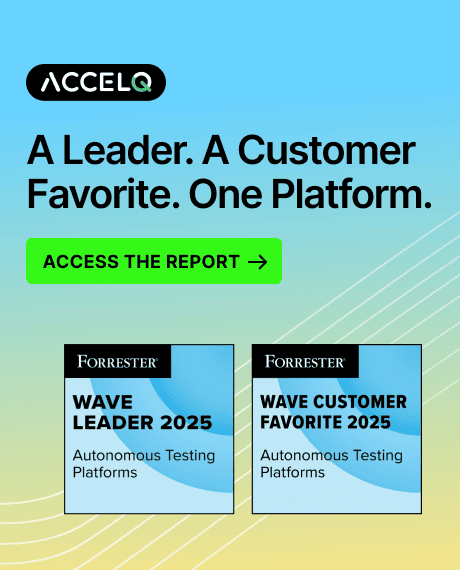Scriptless Test Automation | What, Why It Matters & Examples

In the fast-paced world of digital development, those traditional automation tests will be stretched to their limits. And as the pressure mounts to produce high-quality software quickly, your teams need to be able to easily build and maintain automation at any level without the burden of unnecessary complexity. That’s when scriptless test automation comes to the rescue. By automating the work of hand-coded scripts, it broadens the team of automators, which can help speed up the automation life cycle, without losing depth or flexibility.
This is the first in a series of articles that will present the idea of scriptless test automation — why it is gaining so much popularity, and how a new breed of platforms like ACCELQ is making significant headway with some very powerful AI-driven features.
- What is a Scriptless Test Automation Framework?
- Why Scriptless Automation Matters in Modern QA
- Scriptless Test Automation With Example
- Benefits of Scriptless Automation Testing
- Debunking Scriptless Automation Myths
- How ACCELQ Powers Scriptless Testing?
- Why Scriptless Testing Aligns with DevOps?
- Conclusion
What is a Scriptless Test Automation Framework?
The term “scriptless automation” is used to indicate the ability to develop test cases without writing code. “Rather than scripting in Java, Python, or JavaScript, testers write test logic using a visual interface or natural language. You can perhaps think of it as assembling a Lego set from visual blocks, as opposed to hand-carving each piece.
Features of a scriptless test automation framework include drag-and-drop test flows, business process visual modeling, keyword-driven test creation, and prebuilt reusable components. These are the kind of tools that allow non-technical team members to join test creation, and help to drive automation adoption throughout the organization.
The removal of the coding dependency allows faster development cycles, as well as wider team collaboration (especially in agile and DevOps-configured environments).
Why Scriptless Automation Matters in Modern QA
Traditional automation frameworks do not perform well in dynamic enterprise environments, despite how powerful they are. They are technical, time-consuming to script, and they are a beast to maintain over time. This is what turns test automation into a bottleneck, rather than an accelerant.

1. Accelerates Time-to-Automation
Scriptless tools allow testing to begin even with incomplete UI or early-stage mockups, enabling teams to shift testing left and integrate it earlier into the development lifecycle. ACCELQ, for instance, provides an abstraction that supports early automation even before the actual UI is developed.
If you’re planning for future scalability, understanding how to build a scalable test automation framework is crucial.
2. Reduces Skill Barriers
Since scripting isn’t required, business users, product owners and manual testers can all contribute directly to test automation. This democratization flattens silos and speeds up the testing lifecycle.
3. Boosts Reusability & Maintainability
Scriptless frameworks promote modular test design. Reusable components allow for centralized updates when business logic changes, drastically reducing maintenance overhead.
4. Enhances Test Coverage
By making test cases easier to create and maintain, teams can increase test coverage to cover edge cases and complex user journeys that would be otherwise omitted.
Also, you can speed up running time by running not just one, but several test suites in parallel. Here is how parallel testing can speed up test cycles.
Additionally, scriptless automation is often beneficial for teams operating in highly regulated industries, such as finance, healthcare, or government. Designing auditable, repeatable test processes is achieved without coding, adhering to rigorous regulatory requirements with minimal overhead.
Scriptless Test Automation With Example
Let’s understand this approach with a simple example:
Use Case: Automate login functionality for a banking application.
Traditional Way:
- A developer writes Selenium/Cypress/Playwright scripts.
- Testers maintain Page Object Models.
- Frequent UI changes break test scripts.
Scriptless Way using ACCELQ:
- Tester types actions using the English language in the logic editor, like “Enter Username,” “Enter Password,” and “Click Login.”
- Then, testers add the verification logic in a scriptless way to assert: ” User should land on the dashboard”
- Tests are auto-healed when UI changes, thanks to ACCELQ’s AI-powered self-healing.
This dramatically reduces script creation time and flakiness. You can see how this works in ACCELQ’s self-healing automation capabilities.
Benefits of Scriptless Automation Testing
Reasons why organizations have been transitioning towards scriptless automation are obvious:
- Faster ROI: Faster test development and reduced scripting effort means less investment over the life of your test suite.
- Collaboration at Ease: Non-tech team members can contribute to the construction and execution of tests.
- Early Automation: Tests can be created off mock views and mock design flows prior to the real app being completed.
- Better scalability: Automation scaling is better across modules and teams of an enterprise.
- Integration with DevOps: It helps continuous integration & deployment (CI/CD) by being an easy-to-use pipeline plugin.
To better understand how this fits into your DevOps lifecycle, refer to this detailed CI/CD pipeline guide.
Moreover, many modern businesses struggle with test maintenance costs. Scriptless testing solves this by significantly lowering the total cost of ownership (TCO). Since tests are created with reusable, abstracted modules, organizations spend less time reworking scripts after each sprint, leading to more predictable release cycles.
🚀Ready for AI-Powered QA?
Get the Whitepaper and transform your automation strategy.
Debunking Scriptless Automation Myths
Despite its rise in popularity, scriptless testing still faces some skepticism. Let’s break a few myths:
Myth 1: Scriptless = Limited Functionality
Fact: Modern platforms like ACCELQ provide support for API chaining, database validations, Mainframe automation, email validations, PDF validations, and multi-environment orchestration—all without code.
Myth 2: Only for Manual Testers
Fact: Scriptless doesn’t exclude technical users; it enhances productivity by allowing testers to focus on business logic rather than syntax.
Myth 3: Cannot be customized
Fact: ACCELQ offers extensibility using user extensions when deeper integrations or logic branching are needed.
👉 Unlock Customization Power
Learn How to Build User Extensions in ACCELQ – Explore the Step-by-Step Guide
How ACCELQ Powers Scriptless Testing?
ACCELQ stands out as an industry leader in scriptless test automation. Here’s why:
Make an early investment in intelligent testing, then scale with assurance. Click ACCELQ Contact us to get in touch with us right now.
- Visual Process Modeling: Tests are modeled as business processes, not just low-level steps.
- Self-Healing Engine: When UI elements change, ACCELQ intelligently adapts locators.
- Built-in DevOps Integration: Supports tools like Jenkins, Jira, GitHub, Azure DevOps.
- Multi-Channel Coverage: Supports Web, Mobile, API, Backend, and Desktop in one codeless platform.
Explore more use cases in mobile app testing and API test automation best practices.
Why Scriptless Testing Aligns with DevOps?
DevOps is highly dependent on continuous delivery and feedback. It helps to speed up the process with reduced cycle times, increased visibility in testing, enhanced defect tracking, and more.
ACCELQ’s robust integrations and abstraction capabilities allow QA to move in tandem with development and operations. The power of scriptless testing with DevOps goes well beyond automation velocity. It promotes a shared ownership model for quality, where quality engineering is not a stage within the SDLC but a continuous endeavor. This change leads to faster feedback loops, higher product quality, and more satisfied customers.
Final Thoughts
Scriptless test automation is transforming how teams look at quality. Organizations experience increased agility, faster time to market, and improved collaboration across teams by breaking down scripting silos. Companies like ACCELQ enhance this advantage by providing business-process-driven automation, AI-infused intelligence, and DevOps compatibility without any code.
Get your demo and plan your strategy accordingly.
Prashanth Punnam
Sr. Technical Content Writer
With over 8 years of experience transforming complex technical concepts into engaging and accessible content. Skilled in creating high-impact articles, user manuals, whitepapers, and case studies, he builds brand authority and captivates diverse audiences while ensuring technical accuracy and clarity.
You Might Also Like:
 Modernizing Legacy Automation Frameworks: When to Migrate & What to Use
Modernizing Legacy Automation Frameworks: When to Migrate & What to Use
Modernizing Legacy Automation Frameworks: When to Migrate & What to Use
 Migration From TestProject to ACCELQ
Migration From TestProject to ACCELQ
Migration From TestProject to ACCELQ
 What is Selenium? What are the challenges in Selenium Automation?
What is Selenium? What are the challenges in Selenium Automation?

































